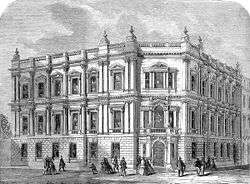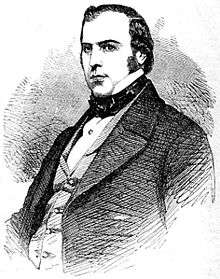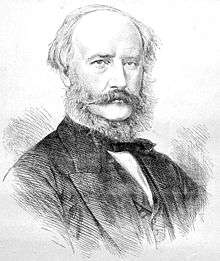Metropolitan Board of Works
The Metropolitan Board of Works (MBW) was the principal instrument of London-wide government from December 1855 until the establishment of the London County Council in March 1889. Its principal responsibility was to provide infrastructure to cope with London's rapid growth, which it accomplished. The MBW was an appointed rather than elected body. This lack of accountability made it unpopular with Londoners, especially in its latter years when it fell prey to corruption.
Metropolitan Board of Works | |
|---|---|
| Type | |
| Type | Board of works of The Metropolis |
| Houses | Unicameral |
Term limits | Three years[1] |
| History | |
| Founded | December 1855 |
| Disbanded | March 1889 |
| Preceded by | |
| Succeeded by | London County Council |
| Leadership | |
Chairman |
|
| Structure | |
| Seats |
|
| Committees |
|
Length of term | Three years, with one third of board appointed every year |
| Elections | |
| Indirect election | |
| Meeting place | |
 | |
| Spring Gardens (1859–1889) | |
Background
London's growth had rapidly accelerated with the increase in railway commuting from the 1830s onwards. However, its local government was chaotic, with hundreds of authorities having varying fields of responsibility and overlapping geographic boundaries. Providing a specific service in a given area might need the co-ordination of many of these authorities.
In 1835 elected municipal boroughs had been set up covering every major city except London. The City of London, only the very core of the sprawling metropolis, was untouched by the Municipal Corporations Act 1835 and resisted all moves to expand its borders to include the poorer inner-city districts surrounding it. This meant that three counties had authority over the metropolitan area: Middlesex covered the area north of the Thames and west of the River Lea, Surrey the area to the south and south-west, and Kent the far south east.
In 1837 an attempt was made to set up a London-wide elected authority; however, the wealthier districts of Marylebone and Westminster resisted this and ultimately defeated the move. In 1854 the Royal Commission on the City of London proposed to divide London into seven boroughs, each represented on a Metropolitan Board of Works. The proposal to divide the city into boroughs was abandoned, but the board of works was set up in 1855.
Creation

In order to have a local body to coordinate local work to plan London, Parliament passed the Metropolis Management Act 1855 which created the Metropolitan Board of Works (which also took over the responsibilities of the short-lived Metropolitan Buildings Office and Metropolitan Commission of Sewers, established in 1845 and 1848 respectively). It covered "the Metropolis", the area designated London in the 1851 census (an enlarged variant of the Bills of mortality area fixed in 1726),[2] the alternative proposals had been that it should cover the Metropolitan Police District, the area that coal tax was levied or the area used for the Metropolitan Interments Act 1852.[3]
It was not to be a directly elected body, but instead to consist of members nominated by the vestries who were the principal local authorities. The larger vestries had two members and the City of London had three. In a few areas the vestries covered too small an area, and here they were merged into a district board for the purpose of nominating members to the MBW. There were 45 members, who would then elect a Chairman who was to become a member ex officio. The first nominations took place in December and the Board met first on 22 December 1855 where John Thwaites was elected as Chairman. The board took over the powers, duties and liabilities of the Commission of Sewers and the Buildings Office on 1 January 1856.
Activities
Sewage
A major problem was sewage: most of London's waste was allowed to flow into the Thames resulting in a horrendous smell in the summer months. In 1855 and 1858 there were especially bad summers with the latter being known as "The Great Stink". A notable achievement of the Board was the creation of the core London sewerage system, including 75 miles (120 km) of main and 1000 miles (1650 km) of street sewers, which solved the problem. A large part of the work of the MBW was under the charge of the Chief Engineer, Joseph Bazalgette, previously engineer with the Metropolitan Commission of Sewers.
Streets and bridges
Its other activities included slum clearance, and the driving through of new streets to relieve traffic congestion. The most important streets built were Charing Cross Road, Garrick Street, Northumberland Avenue, Shaftesbury Avenue, and Southwark Street. From 1869 onwards the MBW acquired all the private bridges crossing the River Thames and freed them of tolls. It also rebuilt Putney Bridge, Battersea Bridge, Waterloo Bridge and Hammersmith Bridge. The board wanted to build a new bridge to the east of London Bridge, which had been discussed for many years; in 1878 Bazalgette drew up plans which were estimated at costing £1.25 million. Despite the Treasury refusing to help by extending the coal and wine dues which paid for the board, it went ahead with the plans, but saw its private bill rejected by the House of Commons.
Embankment
The Board also created the three section Thames Embankment from 1864.
Fire brigade
From 1865 the MBW became responsible for administering the Metropolitan Fire Brigade.[4] Architects employed by the MBW who specialised in fire stations included Robert Pearsall, responsible for Fulham Fire Station[5] and Woolwich Fire Station.
Parks and open spaces
In 1856 the MBW obtained an amending act of parliament giving them the power to provide "parks, pleasure-grounds and open spaces", subject to parliamentary approval. Among the parks and open spaces acquired or laid by the board were:[6]
- Finsbury Park (acquired 1857, formally opened 1869)
- Southwark Park (acquired 1864, opened 1869)
- Victoria Embankment Gardens (opened in 1870)
- Leicester Square (opened in 1874)
- Wormwood Scrubs (vested in the MBW in 1879)
- Hampstead Heath (acquired in 1886)
- Battersea Park, Kennington Park, Victoria Park and the gardens surrounding Bethnal Green Museum (taken over from the Office of Works in 1887)
- Clapham Common (transferred to the board's ownership in 1887)
- Wandsworth Common (duties of the conservators transferred to the board in 1887)
- Ravenscourt Park in 1888 and Clissold Park in 1889
- Dulwich Park laid out by the MBW but opened by the successor London County Council in 1890.
Under the Metropolitan Commons Act 1878 the MBW obtained the right to purchase and hold saleable rights in common lands in the Metropolis, in order to preserve the right of public access. The board also purchased the manorial rights in Streatham Common and Tooting Common.
Organisation

The MBW at first had its meetings in the Guildhall of the City of London and its headquarters at Greek Street in Soho. It then built its own headquarters at Spring Gardens (which became a metonym for the MBW), designed by its first chief architect Frederick Marrable and built in an Italianate style in 1859. When John Thwaites died (8 August 1870), he was eventually replaced by James Macnaghten Hogg, later Lord Magheramorne, who remained Chairman until the MBW was abolished. There was an increase in the membership to 59 in 1885 when some district boards were divided and others were given more members.
Scandals
The MBW had very little affection from the people of London. Its status as a joint board insulated its members from any influence of popular opinion, though all property-owners had to pay for its work as part of their local government rates. Worse, the very many building contracts issued by the MBW made membership of it desirable for anyone wishing to bid for them. The MBW took most of its decisions in secret. There were a succession of corruption scandals in the late 1880s, which led to a Royal Commission investigation. By this time, the public had dubbed the MBW as the "Metropolitan Board of Perks".
The essence of the scandal arose from the purchase by the MBW of the old Pavilion music hall in Piccadilly Circus in 1879, when the site was thought necessary for the construction of Shaftesbury Avenue. As the street was still in the early stage, the site was leased to music hall proprietor R.E. Villiers for the time being. In addition to his regular payment to the Board, Villiers paid a small sub rosa amount to F.W. Goddard, who was Chief Valuer for the Board, for favourable treatment.
In 1883, it seemed that demolition of the site for road construction was likely to take place, and Villiers met with Goddard and Thomas James Robertson (Assistant Surveyor) to ensure that the remainder of the site was granted to him for a new Pavilion. They agreed to help him, in return for one corner of the site being a public house under the landlordship of W.W. Grey. Grey was in fact the brother of Robertson, though this was of course not immediately apparent.
In November 1884 Robertson told Villiers that the time had come to make a formal offer to the MBW to lease the site, and Villiers duly offered £2,700 ground rent per annum. The Board instructed its superintending architect, George Vulliamy, to value the site: however, Vulliamy was old and left practically all of the work to his subordinates – Goddard and Robertson (it was said by the Deputy Chairman of the Board that "Mr. Goddard and Mr. Robertson were Mr. Vulliamy"). They prepared a report valuing the site at £3,000 per annum, which Villiers immediately accepted; this was then hurriedly pushed through the Board which agreed to the lease despite a higher offer of £4,000.
The site was leased off in two portions, £2,650 for the largest part, and £350 for the western corner of the site. Goddard continued to collect his extra payments from Villiers, and the western corner was transferred to Grey – who sold his existing public house on Tichborn Street and divided the £10,000 profit between Goddard and Robertson. In December 1886, Villiers sold the Pavilion, and Goddard received a total of £5,000 of the proceeds.
Subsidiary corruption
For years, vague hints had been made that the Board tended to encourage those applying for leases to employ members of the Board as architects. In particular, James Ebenezer Saunders had been appointed as chief architect on the Pavilion, and on the Grand Hotel and Metropole Hotel on Northumberland Avenue, both on land owned by the Board, and had done little actual work. Francis Hayman Fowler, although he had done much other work as a Board member, had taken money from site owners and lessees in circumstances which clearly indicated bribery.
On a more base level, the Assistant Architect at the Board, John Hebb, had responsibility for inspecting theatres for safety. He began to write to the managers of theatres with upcoming inspections to suggest that they might want to send him free tickets. Given the power of the board to close theatres, most complied. However, displeased by the inspections themselves, and by the attempt to extract gifts, the managers tended to send Hebb tickets for seats that were at the back of the house or hidden behind a pillar.
Royal Commission
The Goddard-Robertson scandal was revealed by a series of articles in the Financial News beginning on 25 October 1886. The Board itself undertook an incompetent investigation under the Chairmanship of Magheramorne, which found Robertson was "injudicious in allowing relatives to become tenants of the Board without informing the Board" but could not find anything worthy "of more severe censure". Anti-Board campaigners were not pleased and kept up the pressure. On the motion of Lord Randolph Churchill (who represented Paddington South where anti-Board feeling was at its highest), the House of Commons voted on 16 February 1888 to establish a Royal Commission to inquire into the Board.
The Commission was headed by Lord Herschell and found the main allegations of the Financial News to have been correct, and indeed understated. Some other scandals were also discovered including the corruption of architects who were members of the Board. However, the Commission repudiated the view of critics that corruption was endemic in the Board.
While the Royal Commission was still preparing its hearings, the President of the Local Government Board Charles Ritchie announced that elected County Councils were to be created throughout the United Kingdom. Almost hidden in the Bill were clauses that separated the area of the MBW from the counties of Surrey, Middlesex and Kent and created it as the County of London. This decision was in general what the anti-Board campaigners of the London Municipal Reform League had called for.
Abolition
The Metropolitan Board of Works was abolished by the Local Government Act 1888; and the London County Council had been elected on 21 January 1889, to assume its new powers on 1 April. With the MBW a lame duck, its last weeks were its most inglorious period. The LCC were due to assume financial responsibility; and the MBW began to award large pensions to the retiring officers and large salaries to those who would transfer. The MBW then decided to allow the Samaritan Hospital in Marylebone to use an additional 12 feet of pavement, which the LCC opposed. The LCC wrote to the MBW asking it not to take the decision; the MBW did not reply and gave the permission.
Finally, the MBW received the tenders for the Blackwall Tunnel and decided to take a decision to award the contract at its final meeting. The LCC again wrote asking the MBW to leave the decision to them. The Chairman of the MBW replied (18 March 1889) that it intended to continue. At this the LCC decided to appeal to the government which exercised its power to abolish the MBW and bring the LCC into existence on 21 March 1889.
The magazine Punch printed a cartoon to mark the abolition of the MBW entitled 'Peace to its Hashes', representing the MBW by a black suit of armour (i.e. blackmail). The citation lauded the MBW for showing 'how jobbery may be elevated to the level of the fine arts'.
The MBW's headquarters were taken over by the London County Council as its headquarters until County Hall was built and occupied in 1922; the building was then renamed 'Old County Hall' and continued as a subsidiary office for the LCC until the original hundred-year lease on the site expired in 1958. It was subsequently used for central government offices and demolished in 1971 to make way for a new headquarters for the British Council. The site is adjacent to Admiralty Arch, off The Mall.
Chairmen
- Sir John Thwaites 1855–1870
- James Macnaghten Hogg 1870–1889
References
- Clifton, Gloria C. (1992). Professionalism, Patronage and Public Service in Victorian London. London: The Athlone Press. pp. 17–22. ISBN 9780485113877.
- "Division i. London comprising the districts or poor law unions, sub-districts, parishes and places, included within the limits of the Metropolis, as defined in the present London weekly tables of mortality being parts of the counties of Middlesex, Surrey, and Kent". HISTPOP.ORG. pp. Census > 1851 > Great Britain > Population tables I, Vol. I. England and Wales. Divisions I–VII, 1851. Retrieved 6 May 2016.
- "Metropolitan Local Management, House of Commons Debates 16 March 1855 vol 137 cc699-729". Hansard 1803-2005. Parliament of the United Kingdom. Retrieved 25 January 2014.
- London Fire Brigade | History, key dates (Our history) Archived 18 June 2008 at the Wayback Machine
- Historic England. "FULHAM FIRE STATION, 685, FULHAM ROAD (1079761)". National Heritage List for England. Retrieved 23 December 2013.
- J J Sexby (1905). The Municipal Parks, Gardens, and Open Spaces of London; their history and associations. London: Eliot Stock.
Bibliography
- 'Professionalism, Patronage and Public Service in Victorian London: The Staff of the Metropolitan Board of Works, 1856–1889' by Gloria Clifton (Athlone Press, London, 1992)
- 'The Government of Victorian London, 1855–1889: The Metropolitan Board of Works, the Vestries, and the City Corporation' by David Owen (Harvard University Press, Cambridge MA, 1982)
Architectural plans for the Spring Gardens building (CRES 35/2420 and CRES 35/2421) can be found at The National Archives.